Rainbow PC100+
This describes the technologies associated with the Rainbow PC100+, the machine I am using in WW2014 to read my RX50 collection. Readership is Public
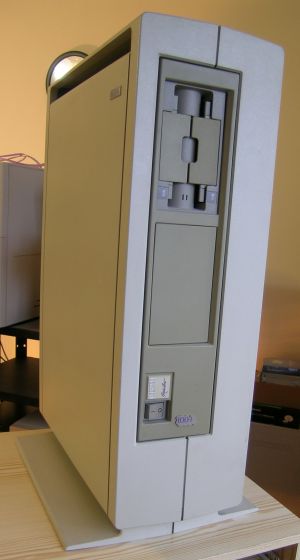 The Rainbow 100+ is a personal computer produced by DEC in the early
1980s. My employer in those years procured a lot of them and later on
made it possible for staff to acquire them for £100. I got two
in September 1988 and used them in various ways for quite a while.
The Rainbow 100+ is a personal computer produced by DEC in the early
1980s. My employer in those years procured a lot of them and later on
made it possible for staff to acquire them for £100. I got two
in September 1988 and used them in various ways for quite a while.
These systems are unusual in that they have two CPUs of different architecture. A Zilog Z80 and and Intel 8088. The firmware also includes VT102 terminal emulation, so they could be used in that way to talk to the VAXen which were my main focus.
The Z80 was used to run CP/M, but I didn't really spend any time with that. Mostly it would boot the 8088 into MS-DOS 2.11. The Z80 still had an active role in accessing the RX50 controller.
The system could be installed in a fibre-glass floor-standing cabinet as illustrated.
The main role of this machine in this Winter Warmup is to read the RX50 disks and stage their contents onto hard disk for cataloging and forwarding on to archive storage.
System components
The entire Rainbow system consists of the system box, a VR241-A Monitor an LK201 keyboard and a special cable to join them up.
This particular system has a 20MB hard disk, "Drive W", for "Winchester"
the dual RX50 disk subsystem, 896K of RAM and a graphics subsystem.

At the rear are two DB25 serial connectors for communications and printer, the video interface and 7 diagnostic indicators. Observe that there is no network connector.
VR241-A
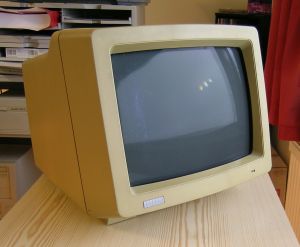 This unit weighs 16.6kg and the Owner's
Guide[1] says that
it requires two people to lift it. I have three of these monitors.
Its technical specifications as listed in
[2] are:
This unit weighs 16.6kg and the Owner's
Guide[1] says that
it requires two people to lift it. I have three of these monitors.
Its technical specifications as listed in
[2] are:
- RGB Color Composite video (RS170 compatible)
- 33vm diagonal, high resolution color
- 0.31mm dot pitch with bonded 62% anti-glare filter
- 24cmx15cm active raster size
- Synchronisation selectable on green or external
- 60Hz vertical rate
- 15.72kHz horizontal rate
- 20MHz bandwidth
- 85W power consumption through a 2.5A fuse.
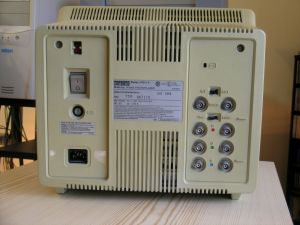 Here's the back of the monitor. It is designed to allow a further
monitor to be slaved from it. Incidentally, it is theoretically
possible to attach separate text and graphics monitors to a Rainbow,
but no external connectors to do that have been provided. Such an
arrangement might have been quite useful in those days.
Here's the back of the monitor. It is designed to allow a further
monitor to be slaved from it. Incidentally, it is theoretically
possible to attach separate text and graphics monitors to a Rainbow,
but no external connectors to do that have been provided. Such an
arrangement might have been quite useful in those days.
LK201
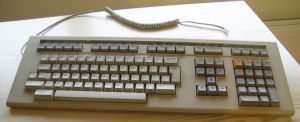 I think this is my favourite keyboard. My fingers are used to the
spacing, layout and general feel. The shift key is in the right place.
Perhaps in a future retrochallenge I'll try to make it usable with
all my systems. I have four of these keyboards. There is a lot to say
about them and I may expand on this section in the future.
I think this is my favourite keyboard. My fingers are used to the
spacing, layout and general feel. The shift key is in the right place.
Perhaps in a future retrochallenge I'll try to make it usable with
all my systems. I have four of these keyboards. There is a lot to say
about them and I may expand on this section in the future.
BCC17
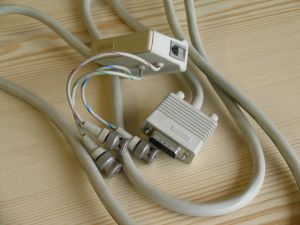 And then there's this thing. It connects the Rainbow's video connector
to the VR241-A and the LK201, which plugs into the
little socket in the top. I think I used to have gadgets that fixed
this assembly to the back of the VR241-A, but they have become hidden
somewhere. I have quite a few of these cables - someone once left a
box of them on my doorstep.
And then there's this thing. It connects the Rainbow's video connector
to the VR241-A and the LK201, which plugs into the
little socket in the top. I think I used to have gadgets that fixed
this assembly to the back of the VR241-A, but they have become hidden
somewhere. I have quite a few of these cables - someone once left a
box of them on my doorstep.
Notes
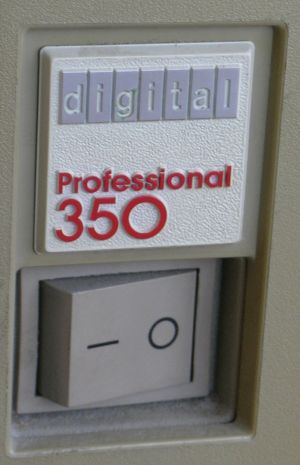 So that's the Rainbow. This is not the same kind of machine at all
as the PRO-350s I have which also would have read the RX50s. But
there would be a whole other set of distractions with these - perhaps
in another Retrochallenge.
So that's the Rainbow. This is not the same kind of machine at all
as the PRO-350s I have which also would have read the RX50s. But
there would be a whole other set of distractions with these - perhaps
in another Retrochallenge.
References
- [1] VR241-A Color Video Monitor Installation/Owner's Guide. EK-VR241-IN-001. Digital Equipment Corporation. June 1983.
- End user instructions.
- [1] Rainbow™ Technical Manual Addendum for models PC100-A, PC100-B and Rainbow 100+. EK-RB100-TM-001. Digital Equipment Corporation. December 1984.
- Gives specific technical details about the different Rainbow models.
Updates
This document is maintained by Pute. Comments should be addressed to PNJ at XQWV dot ORG dot UK.- PNJ, 2014-01-22. Original version.